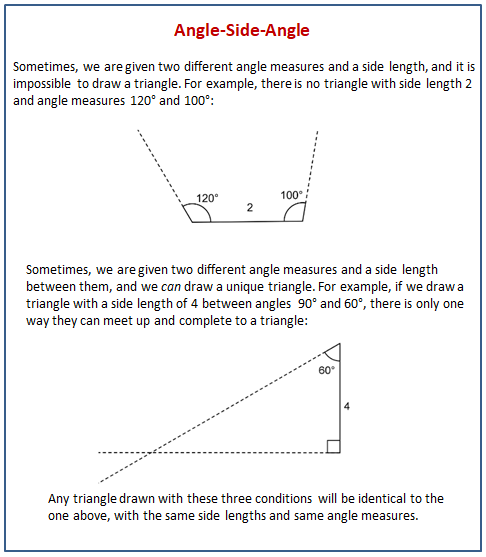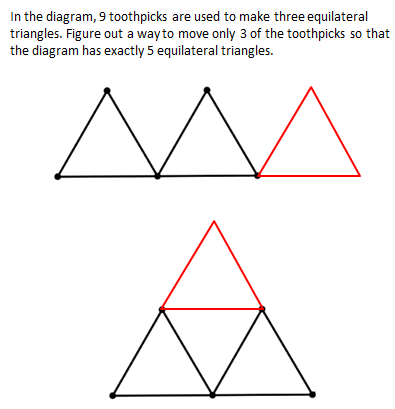Illustrative Mathematics Grade 7, Unit 7, Lesson 9: Drawing Triangles (Part 1)
Learning Targets:
- I understand that changing which sides and angles are next to each other can make different triangles.
Related Pages
Illustrative Math
Grade 7
Lesson 9: Drawing Triangles (Part 1)
Let’s contrast triangles.
Illustrative Math Unit 7.7, Lesson 9 (printable worksheets)
Lesson 9 Summary
The following diagrams explain how to draw triangles when given angle, side and angle.

Lesson 9.1 Which One Doesn’t Belong: Triangles
Which one doesn’t belong?
Lesson 9.2 Does Your Triangle Match Theirs?
Three students have each drawn a triangle. For each description of a student’s triangle:
- Drag the vertices to create a triangle with the given measurements.
- Compare their measurements to the other side lengths and angle measures in your triangle.
- Decide whether the triangle you made must be an identical copy of the triangle that the student drew. Explain your reasoning.
Jada’s triangle has one angle measuring 75°.
Andre’s triangle has one angle measuring 75° and one angle measuring 45°.
Lin’s triangle has one angle measuring 75°, one angle measuring 45°, and one side measuring 5 cm.
Lesson 9.3 How Many Can You Draw?
- Draw as many different triangles as you can with each of these sets of measurements:
a. Two angles measure 60°, and one side measures 4 cm.
b. Two angles measure 90°, and one side measures 4 cm.
c. One angle measures 60°, one angle measures 90°, and one side measures 4 cm. - Which sets of measurements determine one unique triangle? Explain or show your reasoning.
Are you ready for more?
In the diagram, 9 toothpicks are used to make three equilateral triangles. Figure out a way to move only 3 of the toothpicks so that the diagram has exactly 5 equilateral triangles.
Lesson 9 Practice Problems
- Use a protractor to try to draw each triangle. Which of these three triangles is impossible to draw?
a. A triangle where one angle measures 20° and another angle measures 45°
b. A triangle where one angle measures 120° and another angle measures 50°
c. A triangle where one angle measures 90° and another angle measures 100° - A triangle has an angle measuring 90°, an angle measuring 20°, and a side that is 6 units long. The 6-unit side is in between the 90° and 20° angles.
a. Sketch this triangle and label your sketch with the given measures.
b. How many unique triangles can you draw like this? - a. Find a value for x that makes -x less than 2x.
b. Find a value for x that makes -x greater than 2x. - One of the particles in atoms is called an electron. It has a charge of -1. Another particle in atoms is a proton. It has charge of +1.
The overall charge of an atom is the sum of the charges of the electrons and the protons. Here is a list of common elements.
Find the overall charge for the rest of the atoms on the list. - A factory produces 3 bottles of sparkling water for every 7 bottles of plain water. If those are the only two products they produce, what percentage of their production is sparkling water? What percentage is plain?
The Open Up Resources math curriculum is free to download from the Open Up Resources website and is also available from Illustrative Mathematics.
Try out our new and fun Fraction Concoction Game.
Add and subtract fractions to make exciting fraction concoctions following a recipe. There are four levels of difficulty: Easy, medium, hard and insane. Practice the basics of fraction addition and subtraction or challenge yourself with the insane level.

We welcome your feedback, comments and questions about this site or page. Please submit your feedback or enquiries via our Feedback page.
